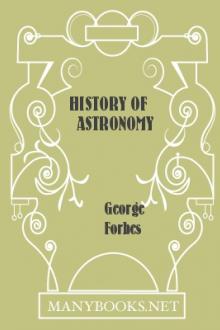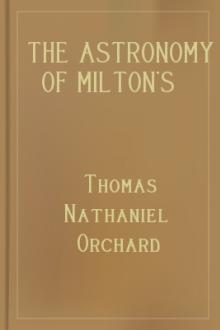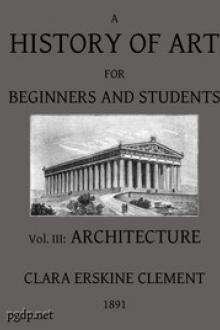History of Astronomy by George Forbes (classic children's novels TXT) 📕

- Author: George Forbes
- Performer: -
Book online «History of Astronomy by George Forbes (classic children's novels TXT) 📕». Author George Forbes
The Chaldæans, being the most ancient Babylonians, held the same station and dignity in the State as did the priests in Egypt, and spent all their time in the study of philosophy and astronomy, and the arts of divination and astrology. They held that the world of which we have a conception is an eternal world without any beginning or ending, in which all things are ordered by rules supported by a divine providence, and that the heavenly bodies do not move by chance, nor by their own will, but by the determinate will and appointment of the gods. They recorded these movements, but mainly in the hope of tracing the will of the gods in mundane affairs. Ptolemy (about 130 A.D.) made use of Babylonian eclipses in the eighth century B.C. for improving his solar and lunar tables.
Fragments of a library at Agade have been preserved at Nineveh, from which we learn that the star-charts were even then divided into constellations, which were known by the names which they bear to this day, and that the signs of the zodiac were used for determining the courses of the sun, moon, and of the five planets Mercury, Venus, Mars, Jupiter, and Saturn.
We have records of observations carried on under Asshurbanapal, who sent astronomers to different parts to study celestial phenomena. Here is one:—
To the Director of Observations,—My Lord, his humble servant Nabushum-iddin, Great Astronomer of Nineveh, writes thus: “May Nabu and Marduk be propitious to the Director of these Observations, my Lord. The fifteenth day we observed the Node of the moon, and the moon was eclipsed.”
The Phoenicians are supposed to have used the stars for navigation, but there are no records. The Egyptian priests tried to keep such astronomical knowledge as they possessed to themselves. It is probable that they had arbitrary rules for predicting eclipses. All that was known to the Greeks about Egyptian science is to be found in the writings of Diodorus Siculus. But confirmatory and more authentic facts have been derived from late explorations. Thus we learn from E. B. Knobel[2] about the Jewish calendar dates, on records of land sales in Aramaic papyri at Assuan, translated by Professor A. H. Sayce and A. E. Cowley, (1) that the lunar cycle of nineteen years was used by the Jews in the fifth century B.C. [the present reformed Jewish calendar dating from the fourth century A.D.], a date a “little more than a century after the grandfathers and great-grandfathers of those whose business is recorded had fled into Egypt with Jeremiah” (Sayce); and (2) that the order of intercalation at that time was not dissimilar to that in use at the present day.
Then again, Knobel reminds us of “the most interesting discovery a few years ago by Father Strassmeier of a Babylonian tablet recording a partial lunar eclipse at Babylon in the seventh year of Cambyses, on the fourteenth day of the Jewish month Tammuz.” Ptolemy, in the Almagest (Suntaxis), says it occurred in the seventh year of Cambyses, on the night of the seventeenth and eighteenth of the Egyptian month Phamenoth. Pingré and Oppolzer fix the date July 16th, 533 B.C. Thus are the relations of the chronologies of Jews and Egyptians established by these explorations.
FOOTNOTES:
[1] These ancient dates are uncertain.
[2] R. A. S. Monthly Notices, vol. lxviii., No. 5, March, 1908.
3. ANCIENT GREEK ASTRONOMY.
We have our information about the earliest Greek astronomy from Herodotus (born 480 B.C.). He put the traditions into writing. Thales (639-546 B.C.) is said to have predicted an eclipse, which caused much alarm, and ended the battle between the Medes and Lydians. Airy fixed the date May 28th, 585 B.C. But other modern astronomers give different dates. Thales went to Egypt to study science, and learnt from its priests the length of the year (which was kept a profound secret!), and the signs of the zodiac, and the positions of the solstices. He held that the sun, moon, and stars are not mere spots on the heavenly vault, but solids; that the moon derives her light from the sun, and that this fact explains her phases; that an eclipse of the moon happens when the earth cuts off the sun’s light from her. He supposed the earth to be flat, and to float upon water. He determined the ratio of the sun’s diameter to its orbit, and apparently made out the diameter correctly as half a degree. He left nothing in writing.
His successors, Anaximander (610-547 B.C.) and Anaximenes (550-475 B.C.), held absurd notions about the sun, moon, and stars, while Heraclitus (540-500 B.C.) supposed that the stars were lighted each night like lamps, and the sun each morning. Parmenides supposed the earth to be a sphere.
Pythagoras (569-470 B.C.) visited Egypt to study science. He deduced his system, in which the earth revolves in an orbit, from fantastic first principles, of which the following are examples: “The circular motion is the most perfect motion,” “Fire is more worthy than earth,” “Ten is the perfect number.” He wrote nothing, but is supposed to have said that the earth, moon, five planets, and fixed stars all revolve round the sun, which itself revolves round an imaginary central fire called the Antichthon. Copernicus in the sixteenth century claimed Pythagoras as the founder of the system which he, Copernicus, revived.
Anaxagoras (born 499 B.C.) studied astronomy in Egypt. He explained the return of the sun to the east each morning by its going under the flat earth in the night. He held that in a solar eclipse the moon hides the sun, and in a lunar eclipse the moon enters the earth’s shadow—both excellent opinions. But he entertained absurd ideas of the vortical motion of the heavens whisking stones into the sky, there to be ignited by the fiery firmament to form stars. He was prosecuted for this unsettling opinion, and for maintaining that the moon is an inhabited earth. He was defended by Pericles (432 B.C.).
Solon dabbled, like many others, in reforms of the calendar. The common year of the Greeks originally had 360 days—twelve months of thirty days. Solon’s year was 354 days. It is obvious that these erroneous years would, before long, remove the summer to January and the winter to July. To prevent this it was customary at regular intervals to intercalate days or months. Meton (432 B.C.) introduced a reform based on the nineteen-year cycle. This is not the same as the Egyptian and Chaldean eclipse cycle called Saros of 223 lunations, or a little over eighteen years. The Metonic cycle is 235 lunations or nineteen years, after which period the sun and moon occupy the same position relative to the stars. It is still used for fixing the date of Easter, the number of the year in Melon’s cycle being the golden number of our prayer-books. Melon’s system divided the 235 lunations into months of thirty days and omitted every sixty-third day. Of the nineteen years, twelve had twelve months and seven had thirteen months.
Callippus (330 B.C.) used a cycle four times as long, 940 lunations, but one day short of Melon’s seventy-six years. This was more correct.
Eudoxus (406-350 B.C.) is said to have travelled with Plato in Egypt. He made astronomical observations in Asia Minor, Sicily, and Italy, and described the starry heavens divided into constellations. His name is connected with a planetary theory which as generally stated sounds most fanciful. He imagined the fixed stars to be on a vault of heaven; and the sun, moon, and planets to be upon similar vaults or spheres, twenty-six revolving spheres in all, the motion of each planet being resolved into its components, and a separate sphere being assigned for each component motion. Callippus (330 B.C.) increased the number to thirty-three. It is now generally accepted that the real existence of these spheres was not suggested, but the idea was only a mathematical conception to facilitate the construction of tables for predicting the places of the heavenly bodies.
Aristotle (384-322 B.C.) summed up the state of astronomical knowledge in his time, and held the earth to be fixed in the centre of the world.
Nicetas, Heraclides, and Ecphantes supposed the earth to revolve on its axis, but to have no orbital motion.
The short epitome so far given illustrates the extraordinary deductive methods adopted by the ancient Greeks. But they went much farther in the same direction. They seem to have been in great difficulty to explain how the earth is supported, just as were those who invented the myth of Atlas, or the Indians with the tortoise. Thales thought that the flat earth floated on water. Anaxagoras thought that, being flat, it would be buoyed up and supported on the air like a kite. Democritus thought it remained fixed, like the donkey between two bundles of hay, because it was equidistant from all parts of the containing sphere, and there was no reason why it should incline one way rather than another. Empedocles attributed its state of rest to centrifugal force by the rapid circular movement of the heavens, as water is stationary in a pail when whirled round by a string. Democritus further supposed that the inclination of the flat earth to the ecliptic was due to the greater weight of the southern parts owing to the exuberant vegetation.
For further references to similar efforts of imagination the reader is referred to Sir George Cornwall Lewis’s Historical Survey of the Astronomy of the Ancients; London, 1862. His list of authorities is very complete, but some of his conclusions are doubtful. At p. 113 of that work he records the real opinions of Socrates as set forth by Xenophon; and the reader will, perhaps, sympathise with Socrates in his views on contemporary astronomy:—
With regard to astronomy he [Socrates] considered a knowledge of it desirable to the extent of determining the day of the year or month, and the hour of the night, … but as to learning the courses of the stars, to be occupied with the planets, and to inquire about their distances from the earth, and their orbits, and the causes of their motions, he strongly objected to such a waste of valuable time. He dwelt on the contradictions and conflicting opinions of the physical philosophers, … and, in fine, he held that the speculators on the universe and on the laws of the heavenly bodies were no better than madmen (_Xen. Mem_, i. 1, 11-15).
Plato (born 429 B.C.), the pupil of Socrates, the fellow-student of Euclid, and a follower of Pythagoras, studied science in his travels in Egypt and elsewhere. He was held in so great reverence by all learned men that a problem which he set to the astronomers was the keynote to all astronomical investigation from this date till the time of Kepler in the sixteenth century. He proposed to astronomers the problem of representing the courses of the planets by circular and uniform motions.
Systematic observation among the Greeks began with the rise of the Alexandrian school. Aristillus and Timocharis set up instruments and fixed the positions of the zodiacal stars, near to which all the planets in their orbits pass, thus facilitating the determination of planetary motions. Aristarchus (320-250 B.C.)





Comments (0)